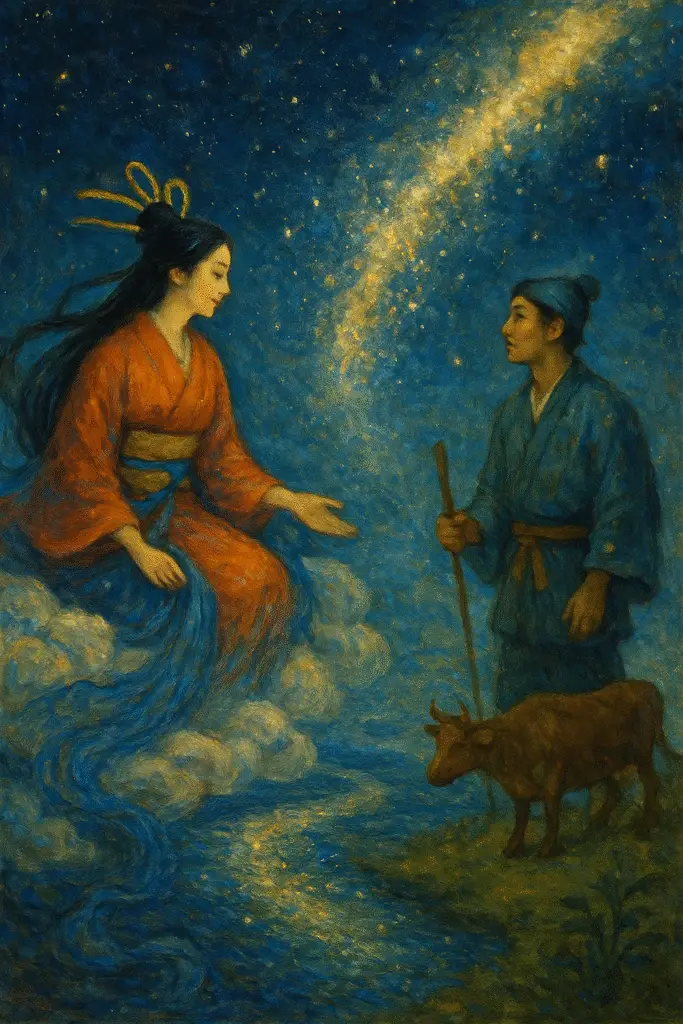
July. It’s that strange halfway point in the year where we all start asking ourselves the same thing:
“Wait… how is it July already?”
For many of us, this is the month where resolutions start feeling distant, motivation dips, and our to-do lists start looking eerily similar to the ones from March. But July isn’t just a marker of time passed—it’s also a perfect moment to pause, reflect, and realign.
And if you need inspiration to do that, Japan has just the story for you: Tanabata (七夕).
Every year on July 7th, people across Japan celebrate Tanabata, the “Star Festival,” based on the romantic legend of two star-crossed lovers, Orihime and Hikoboshi, who are separated by the Milky Way and allowed to meet only once a year. It’s a story about dedication, longing, and patience—values that speak just as loudly in language learning as they do in love.
The Tale of Orihime and Hikoboshi
In the heavens, Orihime (織姫); the Weaving Princess; was the daughter of Tentei, the Sky King. She spent her days weaving beautiful fabrics along the banks of the Amanogawa, or River of Heaven; what we call the Milky Way. Her weavings were so fine, so luminous, that the gods themselves adorned the skies with her work.
But Orihime was lonely. Concerned for his daughter’s happiness, Tentei introduced her to Hikoboshi (彦星), the Cowherd Star, who lived on the opposite side of the Amanogawa. The moment their eyes met, the two fell hopelessly in love.
Their joy, however, became their undoing.
So enamored were they with each other that Orihime stopped weaving, and Hikoboshi let his celestial herd wander. The Sky King, angered by their neglect of duty, separated them; placing them on opposite ends of the Milky Way. But even his heart softened at the sight of his daughter’s tears. And so, he allowed them one night a year; the seventh day of the seventh lunar month; to meet, if the skies were clear.
If it rains on that night, however, the lovers must wait another year.
A Festival Written in the Stars
Tanabata is not just a tale of love; it is a reflection of deeply held values in Japanese culture: duty, discipline, longing, and perseverance. Orihime and Hikoboshi are not punished for love, but rather reminded that love must coexist with purpose. Their reunion is brief, but it is made meaningful because they endure the wait.
During Tanabata, people write their wishes on tanzaku; narrow strips of colorful paper; and hang them on bamboo branches, along with origami decorations. These wishes are often for self-improvement, dreams for the future, or hopes for love, echoing the spirit of the two stars in the sky.
Kyoto, Sendai, and other cities host spectacular Tanabata festivals, where glowing lanterns, yukata-clad crowds, and street parades bring this celestial legend to life.
Why This Story Still Matters
Tanabata’s legend may be over a thousand years old, but its themes feel timeless. In a world where everything is instant, the idea of waiting a whole year for something—or someone—you love is profound. It’s a story about dedication, restraint, and holding on to hope, even across vast distances.
For those learning Japanese, the story of Tanabata offers more than cultural insight; it mirrors the journey of language acquisition itself. Like Orihime and Hikoboshi, learners must work, wait, and stay the course, trusting that their persistence will lead to a moment of clarity, connection, and joy.
The Milky Way may seem like a vast divide; but once a year, even stars can meet.
This Tanabata, try writing your own tanzaku. What do you wish for in your learning journey? What are you hoping to weave into your future? Hang it on a plant, pinboard, or window; and let it remind you that every small step is part of a longer path, guided by stars.
